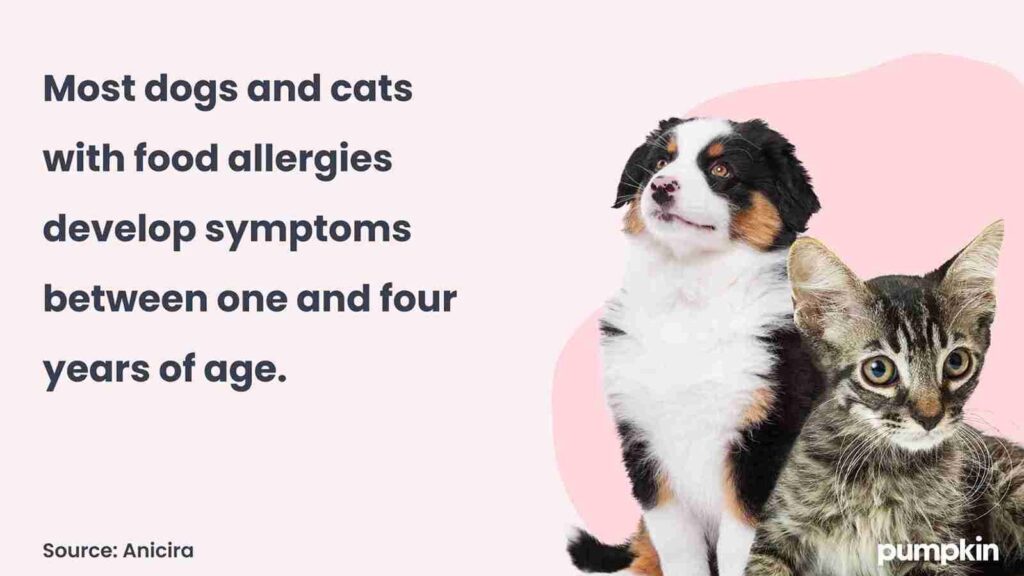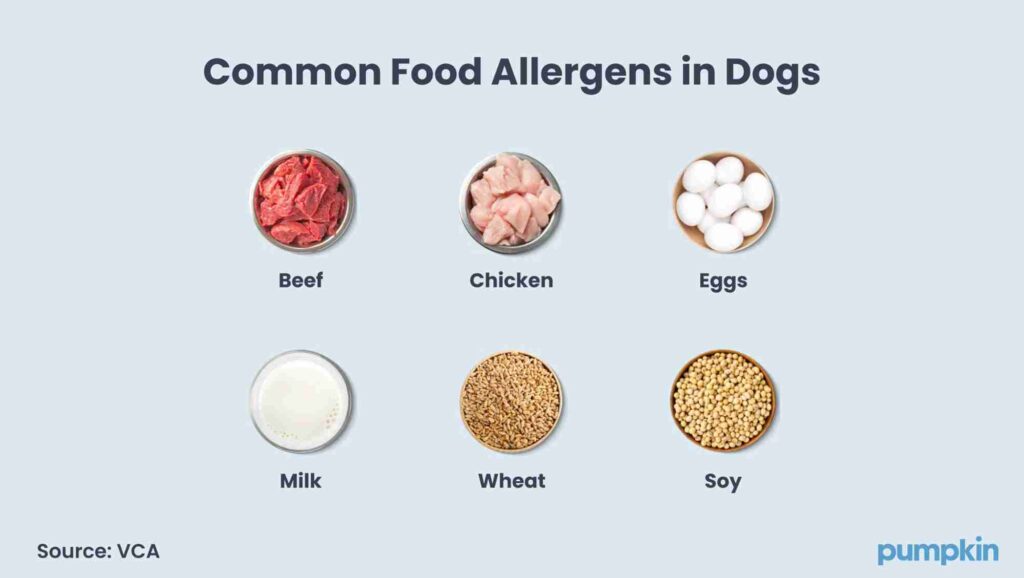Key Points
- Just like humans, dogs and cats can get food allergies.
- Symptoms of a food allergy include ear infections, itchiness, hot spots, rashes, and sneezing.
- Some breeds are more prone to allergies than others; these include Labrador Retrievers and German Shepherds.
For most pets, food is everything. They can’t wait for dinnertime and will do almost anything for a tasty treat.
While eating can come with paw-licking, tail wagging, and pure joy — this isn’t the case for all animals. If your pup or kitty has an allergy, certain foods can cause a negative reaction.
Just like humans, pets can break out with skin problems, gastrointestinal issues, and even ear infections if they consume the wrong food. Fortunately, while food allergies in dogs and cats exist, they aren’t common.
Keep reading to learn about typical offending foods, clinical signs and symptoms, and how to deal with your cat or dog’s food allergies so they can get back to feeling like their best self.
What is a food allergy?
A food allergy in dogs/cats is similar to that in humans. If your pet has an allergy or intolerance, eating that food will trigger an immune response.
In pets, this is often referred to as cutaneous adverse food reactions (CAFR), a hypersensitivity disorder. There is still a lot to learn about CAFR, and research is ongoing.
CAFR can often be mistaken for atopic dermatitis — a common skin problem in dogs that affects up to 15% of pooches. Atopic dermatitis is caused by environmental allergies, such as pollen and mold. Diagnosis is tricky, but your veterinarian can tell the difference between an animal with CAFR and one with atopic dermatitis.
It can be scary when an unexpected illness slows down your beloved pup, especially when they come back from the vet with an expensive bill. Having a Pumpkin Pet Insurance plan in place can help you afford the best care for your pets when they face unexpected illnesses or accidents in the future.
Food allergy symptoms in dogs and cats
The most common sign of CAFR is year-round itchy skin, often around the head or rear, that doesn’t respond well to antihistamines or corticosteroids.
Here are some of the most common food allergy symptoms in cats and dogs:
- Excessive itching
- Bumps all over the body (in cats)
- Hot spots (skin infections caused by excessive scratching)
- Ear infections
- Vomiting
- Difficulty defecating
- Diarrhea
- Frequent bowel movements
- Hair loss (caused by frequent scratching)
- Itchy skin rashes
- Red eyes (with and without discharge)
- Sneezing
- Itchy paws
Of course, many of these symptoms can be caused by other health conditions, and your vet will be able to guide you to the correct diagnosis and treatment.
At what age do dogs and cats start showing signs of food allergies?
Most dogs and cats with food allergies develop symptoms between their first birthday and about 5 years of age. However, new symptoms can pop up later in life. For cats and dogs, this is anywhere from 6 months or earlier to 15 years old.

If you have a hunch your pet might be showing food allergy symptoms, don’t let their age deter you from seeking treatment.
Dog breeds prone to food allergies
Any dog can develop food allergies, but some breeds are more prone than others. These three breeds are more likely to have a food allergy:
- Labrador Retrievers
- German Shepherds
- West Highland White Terriers
Make sure you monitor your dog when offering them new foods, regardless of their breed.
Cat breeds prone to food allergies
Two-thirds of cats with food allergies are either Siamese or a Siamese mixed breed. Food allergies in cats can be present regardless of breed, but these are the most common.
What are the most common food allergies in dogs and cats?
Dogs and cats can be allergic to almost any food. But, there are a few common culprits.
The most common food allergies in dogs are:

The most common food allergens for cats are chicken, fish, and dairy.
Can dogs and cats have multiple food allergies?
Yes, dogs and cats can develop more than one food allergy. However, they might also be experiencing something else, such as a seasonal allergy, flea allergy, or environmental allergy, at the same time.
Dogs and cats can also be allergic to:
- Pollen
- Mold
- House dust mites
- Cockroach dander
- Fleas
- Contact allergens (like laundry detergent)
Your vet can help you figure out what kind of allergy your pet is experiencing.
How are food allergies diagnosed and treated?
Diagnosing food allergies is challenging in dogs and cats. Your veterinarian will use a combination of information from you (a history), physical examination, and laboratory testing to rule out other causes, such as skin infections.
There is no definite laboratory test for food allergies in pets. The only way to diagnose a food allergy with certainty is with an 8- to 10-week food elimination trial.
During a food elimination trial, your dog or cat will eat either a limited ingredient or hydrolyzed protein food and nothing else. This is to determine if symptoms resolve during the prescription diet. If they do, then it’s likely to be a food allergy caused by their former food or treats. If the elimination diet doesn’t solve the problem, then your vet will probably rule out food allergies.

The length of the trial period is determined by how long it takes for offending allergens to leave your pet’s system. Only use veterinarian-recommended therapeutic foods for elimination diet trials. These diets are free of any other potential allergens that might be present in OTC diet foods.
In some cases, additional vet-prescribed medication might be needed. These include:
- Antihistamines
- Corticosteroids
- Apoquel
- Cytopoint
Flea control is almost always prescribed when indicated. In addition, antibiotics or anti-fungal medication may be prescribed if there are secondary skin infections.
What if the elimination diet isn’t working?
Be patient and communicate regularly with your veterinary provider during this process. It can take several weeks to see improvement. Plus, it can be hard to control what your pet is eating.
Look for the following ‘silent saboteurs’ that can be hindering the elimination diet trial:
- Small children who drop food that your pup consumes.
- Any household members sneakily feeding them treats or “human food”.
- Pets eating another pet’s food.
- Medications or supplements with allergens (heartworm medication is the most common culprit).
- Daycare, boarding facility workers, or petsitters feeding the pet something they shouldn’t.
Get everyone in the household on board and provide instructions to anyone involved in your pet’s care.
Remember, you can always talk to your vet about any concerns that pop up. You can always ask your veterinarian about your pet’s nutritional needs, allergy symptoms, and advice about what to feed them.
FAQs
-
- https://vetfocus.royalcanin.com/en/scientific/feline-cutaneous-adverse-food-reactions
- https://www.vet.cornell.edu/departments-centers-and-institutes/riney-canine-health-center/canine-health-information/atopic-dermatitis-atopy
- https://anicira.org/resources/common-signs-of-a-food-allergy-in-pets
- https://www.dvm360.com/view/specialized-dog-foods-may-curb-cutaneous-adverse-food-reaction
- https://www.vetfolio.com/learn/article/diagnosis-and-management-of-food-allergies-in-dogs-and-cats
- https://vcahospitals.com/know-your-pet/pet-health-articles/food-allergies-in-dogs
- https://vcahospitals.com/know-your-pet/food-allergies-in-cats
- https://veterinaryskinandear.com/food-allergies-in-dogs/



